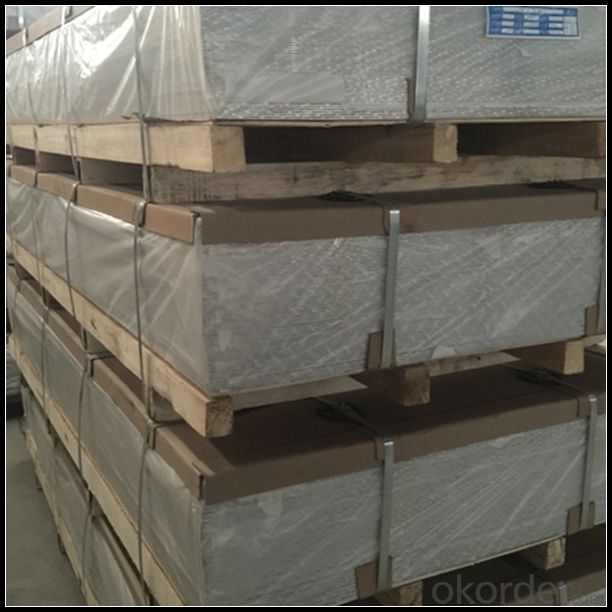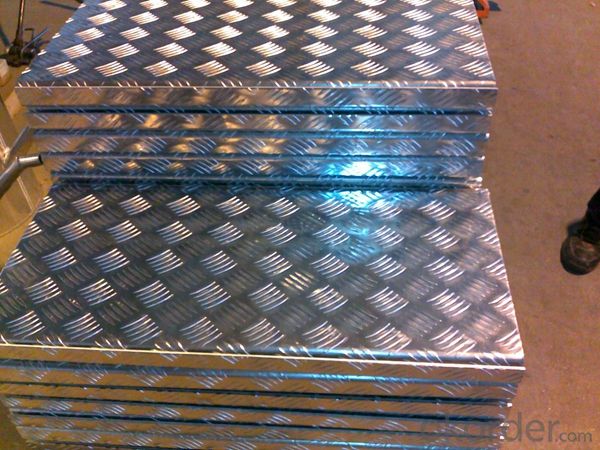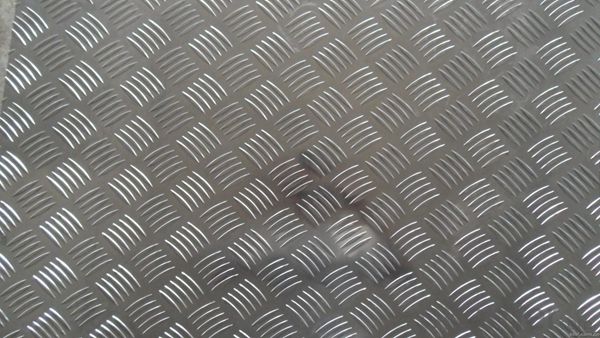Embossed Aluminum Sheet AA1100 for Automotive Body
- Loading Port:
- Shanghai
- Payment Terms:
- TT OR LC
- Min Order Qty:
- 5 m.t.
- Supply Capability:
- 10000 m.t./month
OKorder Service Pledge
OKorder Financial Service
You Might Also Like
Item specifice
1. Specification of Embossed Aluminum Sheet AA1100 for Automotive Body
ALLOY | AA1050 AA1060 AA1070 AA1100 ETC AA3003 AA3004 AA3005 AA3104 AA3105 ETC AA5005 AA5052 AA5083 AA5754 ETC AA8011 AA8006 AA8079 ETC |
TEMPER | H14,H16,H18,H22,H24,H26,H32,O/F |
THICKNESS | ≥0.2MM |
WIDTH | 30mm-2100mm |
COIL WGT | 2Mt - 3Mt |
COIL ID | φ508mm,φ610mm |
SURFACE | PE Protecting film |
STANDARD | GB/T 3880-2006 |
2. Application of Embossed Aluminum Sheet AA1100 for Automotive Body
(1).Interior: wall cladding, ceilings, bathrooms, kitchens and balconies, shutters, doors...
(2).Exterior: wall cladding, facades, roofing, canopies, tunnels,column covers , renovations...
(3).Advertisement: display platforms, signboards, fascia, shop fronts...
3. Feature of Embossed Aluminum Sheet AA1100 for Automotive Body
Surfact Quality :
Be free from Oil Stain, Dent, Inclusion, Scratches, Stain, Oxide Dicoloration, Breaks, Corrosion, Roll Marks, Dirt Streaks and other defect which will interfere with use,
Mechenical Property:
Chemical Composite and Mechanical Property
4. Certificate:
SGS and ROHS(if client request, paid by client), MTC(plant provided), Certificate of Origin(FORM A, FORM E, CO), Bureau Veritas and SGS (if client request, paid by client), CIQS certificate
5. Image of Embossed Aluminum Sheet AA1100 for Automotive Body



6. Package and shipping of Embossed Aluminum Sheet AA1100 for Automotive Body
First, plastic cloth with drying agent inside; Second, Pearl Wool ; Third, wooden cases with dry agent , fumigation wooden pallets, aluminum surface could cover blue PVC film
7. FAQ
1) What is the delivery time?
Dpends on actual order, around 20 to 35 days
2)What is the QC system:
We have QC staff of 20 persons and advanced equipment, each production is with MTC traced from Aluminum ingot lot.
3) What market do you mainly sell to?
Australia, America, Asia, Middle East, Western Europe, Africa etc
- Q:What are the different methods of joining aluminum sheets?
- Aluminum sheets can be joined using a variety of methods, each with its own benefits and suitability for specific applications. These methods include: 1. Welding: Tungsten Inert Gas (TIG) welding, Metal Inert Gas (MIG) welding, and Resistance Spot Welding (RSW) are all techniques that can be used to join aluminum sheets. TIG welding is commonly chosen for thin sheets due to its precise control and high-quality results. MIG welding, on the other hand, is faster and more suitable for thicker sheets. RSW creates strong welds in a short amount of time by using localized heat and pressure. 2. Adhesive bonding: Adhesive bonding involves using specially designed adhesives for joining aluminum. This method provides excellent strength, even distribution of stress, and corrosion resistance. It is often utilized in applications where aesthetics and weight reduction are important, such as in the automotive and aerospace industries. 3. Mechanical fastening: Mechanical fastening methods, such as riveting and bolting, can also be used to join aluminum sheets. Riveting involves deforming a rivet that passes through pre-drilled holes, while bolting uses screws or bolts. These methods are suitable for temporary or semi-permanent joints and offer easy disassembly if needed. 4. Friction stir welding: Friction stir welding is an innovative method that utilizes a rotating tool to generate frictional heat between the aluminum sheets. This creates a plasticized region that is stirred together to form a solid-state weld. Friction stir welding is particularly useful for large and complex aluminum structures, providing high strength and integrity. 5. Clinching: Clinching is a cold-forming process that joins aluminum sheets without the need for heat or additional materials. It involves pressing the sheets together, creating a mechanical interlock and a strong joint. This method is cost-effective, efficient, and suitable for joining dissimilar metals. 6. Laser welding: Laser welding involves using a high-energy laser beam to melt and fuse the aluminum sheets together. It offers precise control, minimal heat input, and high welding speeds, making it suitable for thin and delicate sheets. Laser welding also provides excellent aesthetics and minimal distortion. The choice of joining method depends on various factors, such as application requirements, material thickness, cost considerations, and desired joint strength. Each method has its own advantages and limitations, and selecting the most appropriate method is crucial to ensure a successful and durable joint.
- Q:What is the thickness range available for aluminum sheets?
- The thickness range available for aluminum sheets typically varies from 0.006 inches (0.15mm) to 0.25 inches (6.35mm), depending on the specific requirements and application.
- Q:What is the final concentration of aluminum cation?
- You have to be able to determine the number of moles of Al+3 that each solution contributes to the final solution: 1. aluminum chloride: AlCl3 Multiply the volume (in L) by the molarity to determine the number of moles of each compound dissolved in solution. 0.0431 L x 0.279 M = 0.0120 mol AlCl3 in solution When the AlCl3 in placed in the water, it dissociates to form the following ions: AlCl3 -- Al+3 + 3Cl- So for every one mole of AlCl3 placed in the water, one mole of aluminum ions will dissociate. Therefore, since we have 0.0120 mole of AlCl3 in the solution, that means that the aluminum chloride will contribute 0.0120 Al+3 ions to the final solution. 2. Aluminum sulfate: Al2(SO4)3 Multiply the volume (in L) by the molarity to determine the number of moles of each compound dissolved in solution. 0.0146 L x 0.464 M = 0.00677 mol Al2(SO4)3 in solution When the Al2(SO4)3 in placed in the water, it dissociates to form the following ions: Al2(SO4)3 -- 2Al+3 + 3(SO4)-2 So for every one mole of Al2(SO4)3 placed in the water, two mole of aluminum ions will dissociate. Use the mole ratios of the dissociation reaction to determine the number of moles of Al+3 ions that the aluminum sulfate contributes to the solution. 0.00677 mol Al2(SO4)3 x (2 mol Al+3 ions / 1 mol Al2(SO4)3) = 0.01354 mol Al+3 ions Therefore, the total number of Al+3 ions in solution is the sum: 0.01354 + 0.0120 = 0.02554 mol Al+3 ions The last piece of information needed to determine the concentration of the final solution is the volume of the final solution. Since the two volumes were mixed, the volume of the final solution will be the sum of the two solutions. 0.0431 L + 0.0146 L = 0.0577 L Therefore, to calculate molarity: Molarity = moles of solute / liters of solution Molarity = 0.02554 mol / 0.0577 L = 0.443 M Al+3
- Q:How do I calculate the weight of aluminum sheet? What is the density?
- First calculate the density of each aluminum plate, then calculate the volume, then the density is good, the volume is the weight
- Q:What are the different methods for finishing the edges of aluminum sheets?
- Depending on the desired outcome and application, there are several approaches to finishing the edges of aluminum sheets. One commonly used method is edge trimming, where excess material is removed from the sheet's edges to achieve a smooth and straight edge. This can be accomplished using various tools like shears, saws, or routers. Another technique is edge deburring, which is employed to eliminate any sharp or rough edges left after cutting. Sanding or grinding tools are often utilized to smooth out the edges and produce a more polished finish. Moreover, edge rolling is a method that can be employed to create rolled or rounded edges on aluminum sheets. This is achieved by using a rolling machine that applies pressure to the edges, bending them into the desired shape. For a more decorative finish, edge profiling can be employed. This involves using specialized tools or machines to craft custom edge shapes or designs on the aluminum sheet. It allows for unique and aesthetically pleasing edges that enhance the overall appearance of the sheet. Lastly, edge painting or coating is an option worth considering. This process entails applying a protective or decorative paint or coating to the edges of the aluminum sheet. This not only provides a finished look but also helps protect the edges from corrosion or other damage. Ultimately, the choice of method for finishing the edges of aluminum sheets depends on factors such as the intended use, desired appearance, and specific project requirements.
- Q:Can aluminum sheets be used for flooring?
- Indeed, flooring can utilize aluminum sheets. Lightweight and sturdy, aluminum proves resistant to corrosion, rendering it an appropriate option for a range of flooring uses. Notably, aluminum sheets frequently find employment in industrial, commercial, and residential settings, encompassing warehouses, garages, kitchens, and outdoor areas. These sheets offer commendable strength, effortless installation, and minimal upkeep. Furthermore, aluminum flooring imparts a polished and contemporary aesthetic to any given space. Nevertheless, prudent consideration of factors like thickness, finish, and the unique demands of the flooring project becomes imperative prior to settling on aluminum sheets.
- Q:ive been working with parts for a robot without gloves and ive manged to 3 cuts in my fingers, also my hands get covered with powdered aluminum from sanding the peices, can this be dangerous to my health?
- I dont think its really dangerous but I also dont think its healthy you should try using dust mask when you do that kind of sanding..
- Q:How do aluminum sheets handle extreme temperatures?
- The exceptional ability of aluminum sheets to handle extreme temperatures is widely recognized. This is primarily due to their high thermal conductivity, which enables them to effectively dissipate heat. As a result, they are suitable for applications involving high temperatures. Aluminum, with a melting point of 660 degrees Celsius (1220 degrees Fahrenheit), can withstand a wide range of extreme temperatures without compromising its structural integrity. When exposed to intense heat, aluminum sheets do not easily deform or warp. Consequently, they are ideal for use in environments with high temperatures, such as industrial furnaces, automotive engines, and aerospace applications. Furthermore, aluminum has a low coefficient of thermal expansion, meaning it expands and contracts minimally when subjected to temperature variations. This significantly reduces the risk of cracking or structural damage. On the contrary, aluminum also performs exceptionally well in extremely cold temperatures. It remains durable and retains its strength even in freezing conditions. This makes aluminum sheets suitable for cryogenic applications, including the construction of liquid natural gas tanks or aerospace components that operate in low-temperature environments. In conclusion, aluminum sheets excel in handling extreme temperatures due to their high thermal conductivity, low coefficient of thermal expansion, and excellent structural integrity. Whether subjected to intense heat or extreme cold, aluminum sheets remain stable and reliable, making them the preferred choice in various industries.
- Q:What are the fire-resistant properties of aluminum sheets?
- Aluminum sheets have excellent fire-resistant properties due to their high melting point, which is around 660°C (1220°F). They do not burn or release any harmful gases when exposed to fire. Additionally, the oxide layer that forms naturally on the surface of aluminum provides further protection against fire by acting as a barrier that prevents the metal from direct contact with flames.
- Q:What are the thermal conductivity properties of aluminum sheets?
- Aluminum sheets have excellent thermal conductivity properties. The thermal conductivity of aluminum is approximately 237 Watts per meter-Kelvin (W/mK), which is significantly higher compared to other commonly used metals such as steel or copper. This means that aluminum sheets are highly efficient in transferring heat across their surface. Aluminum's high thermal conductivity allows it to quickly conduct and distribute heat, making it an ideal choice for various applications that require efficient heat transfer, such as heat exchangers, cooling systems, and heat sinks. Additionally, aluminum's lightweight nature and corrosion resistance further contribute to its popularity in thermal management applications. Overall, aluminum sheets offer excellent thermal conductivity properties, making them a preferred material in industries where efficient heat transfer is crucial.
1. Manufacturer Overview |
|
|---|---|
| Location | |
| Year Established | |
| Annual Output Value | |
| Main Markets | |
| Company Certifications | |
2. Manufacturer Certificates |
|
|---|---|
| a) Certification Name | |
| Range | |
| Reference | |
| Validity Period | |
3. Manufacturer Capability |
|
|---|---|
| a)Trade Capacity | |
| Nearest Port | |
| Export Percentage | |
| No.of Employees in Trade Department | |
| Language Spoken: | |
| b)Factory Information | |
| Factory Size: | |
| No. of Production Lines | |
| Contract Manufacturing | |
| Product Price Range | |
Send your message to us
Embossed Aluminum Sheet AA1100 for Automotive Body
- Loading Port:
- Shanghai
- Payment Terms:
- TT OR LC
- Min Order Qty:
- 5 m.t.
- Supply Capability:
- 10000 m.t./month
OKorder Service Pledge
OKorder Financial Service
Similar products
New products
Hot products
Related keywords




























